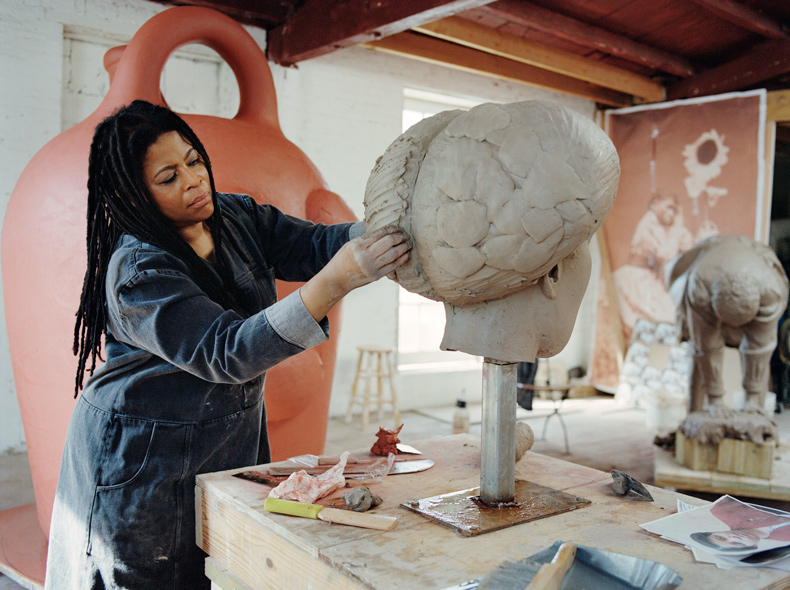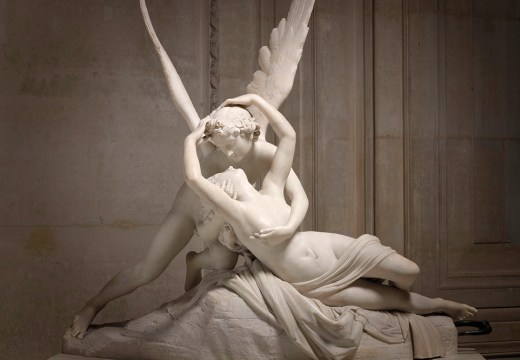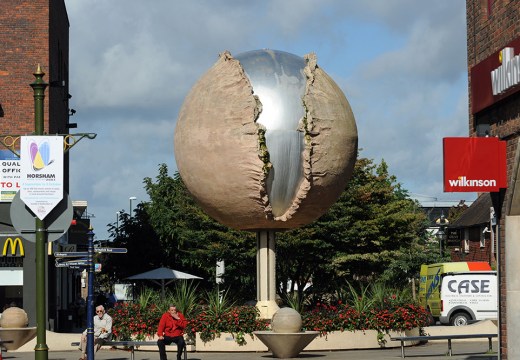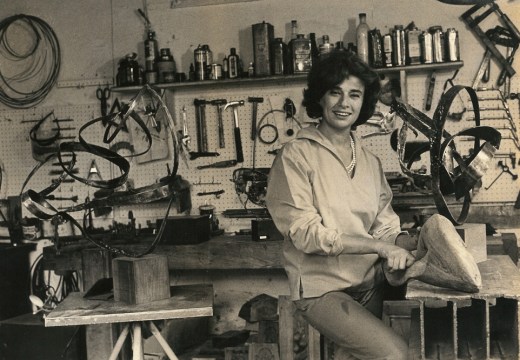From the July/August 2023 issue of Apollo. Preview and subscribe here.
The ICA in Boston is right on the waterfront and when I visited on a rainy weekday morning the air was damp, the sky modulated greys. Outside the museum entrance, rain had pooled on the wooden platform beneath Leigh’s monumental bronze Satellite (2022). Satellite is a four-legged figure-structure, 24-feet high, with a head at once a satellite dish and a D’mba, a headdress. As I came around the building’s corner and saw it, I had a feeling I recognised from other encounters with works by Leigh: it’s sending something out, also it’s receiving, and I can hear it, also I can’t.
Simone Leigh’s sculptures are on many different scales: elongated bronzes tower; ceramic busts are the size of a small child; eight- and nine-foot-tall figure-buildings and building-figures join the massiveness of a house or a mother’s skirt to the hand-heldness of a jug, a cowrie shell, a mailbox, a face. Despite their great variety, on the occasions when I have stood with them, each has seemed to have a palpable force field around it. The sculptures are unto themselves and they are always in relation to other bodies.
Curated by Eva Respini in close collaboration with Simone Leigh, the ICA exhibition brings together decades of Leigh’s work in materials not usually part of the same practice: bronze, video, ceramic, raffia – and it alludes to her ongoing work with other people in performance, installation, retreats and staged conversations. Continuing the collaboration of the ICA and Leigh that made such a strong impression last year at the Venice Biennale, (where Leigh, as it is said, ‘represented’ the United States), the exhibition in Boston is a wonderful consideration of works that were in Venice together with many others that were not shown, or have been made since. The catalogue, unusually, is an integral part of the show. A number of its writers (including Saidiya Hartman, Christina Sharpe, Vanessa Agard-Jones, Hortense Spillers, Sharifa Rhodes-Pitts and many more) are close interlocutors of Leigh’s; they are among the people to whom her sculptures are addressed.
Simone Leigh’s sculptures, as Hortense Spillers writes, combine ‘elements of portraiture and of architecture (or more precisely built space) in the very same spatiotemporal breath’. Architecture is a social art, and, in Leigh’s architectural sculpture, material, like scale, can imply other people. A 24-four-foot bronze cannot have arrived outside the ICA without many hands. The work’s force field seems to remind us that the sculptor herself has spent years and months moulding the clay beginnings and working with others who participate as models, and who cast bronze, fire ceramics, haul, install or write.

Simone Leigh in her studio, 2021. Photo: Shaniqwa Jarvis; courtesy the artist. Artworks; © Simone Leigh
A phrase for the atmosphere of Leigh’s work might be somebody knows this. The sound of the word ‘somebody’ feels very definite, as in ‘somebody must know what happened’, yet always holds a question: is there really such a somebody, if there were, wouldn’t the person have a name? (‘Can somebody explain this to me?’) Simone Leigh’s sculptures seem confident that there is a witness, somewhere, at the same time they suggest that the knowing person, who would be a kind of interlocutor for the sculpture, might be quite far away in space or time.
Two rooms at the ICA show videos that make both collaboration and witnessing explicit. my dreams, my works, must wait till after hell… (2011) was made by Leigh and Chitra Ganesh, the title drawn from a magnificent poem by Gwendolyn Brooks which brings that poet’s voice into the room, too. The friend with whom I saw the exhibition noted how the sound of the video’s score, by composer Kaoru Watanabe, reverberates. Sound moves between the lying-down, shallow-breathing torso of the filmed Kenya (Robinson), whose head in the video is covered by rocks, and a sculpture in the room, the dome-shaped ceramic Village Series (2023) with braids outlining its descending contours. The video with its prone figure, half-body, half-stone, is a reflection on sculpture, and it suggests that a sculpture, whether figurative or not, whether a portrait or not, is modelled by somebody, and bears somebody in mind.
The videos point toward those aspects of Leigh’s practice not easily displayed in a museum: events, retreats, temporary installations and performances. In another room, before the video of Conspiracy (2022), made with Madeline Hunt-Erlich, we watch Leigh’s hands work, see a sculpture moved to the edge of the water and set on fire. Within the video, there is a witness to the blaze: the artist and writer Lorraine O’Grady, a mentor to Leigh, who appears as herself. As installed at the ICA, beyond the video, there is another witness: the nine-foot-tall black-bronze sculpture-portrait of the writer and historian Sharifa Rhodes-Pitts. In her own essay for the catalogue, Rhodes-Pitts suggests further ways of thinking about mutual work. One idea is: ‘Naming who is in the room with you;’ another is: ‘We have proceeded along a path but have not arrived.’
Rhodes-Pitts was also a model for the sculpture that creates the most demanding and beautiful space in the exhibition. For Last Garment (2022), a life-size womanly figure washes clothes at the centre of a huge rectangular reflecting pool of water, her bronze surfaces and hands doubled by the water. This is installed so that the glimmering surface of the water is continued through the glass wall of the ICA by the waters of Boston Harbor, the lines travelling out to the docks next to which historic ships suggest terrible trades. Toni Morrison, the catalogue reminds us, wrote that ‘all water has a perfect memory’. As it works to return, water may wear away what we want to hold: stone, bones, raffia, clay, film, but not bronze. Bronze responds to water with tarnish, adding layers to protect itself. Bronze may sound a silent call, and endure.
Simone Leigh is at the Institute of Contemporary Art, Boston, until 4 September.
From the July/August 2023 issue of Apollo. Preview and subscribe here.
Unlimited access from just $16 every 3 months
Subscribe to get unlimited and exclusive access to the top art stories, interviews and exhibition reviews.














![Masterpiece [Re]discovery 2022. Photo: Ben Fisher Photography, courtesy of Masterpiece London](http://www.apollo-magazine.com/wp-content/uploads/2022/07/MPL2022_4263.jpg)
It’s time for the government of London to return to its rightful home